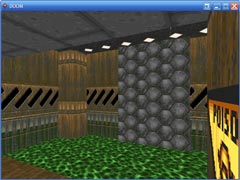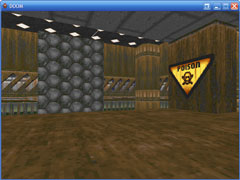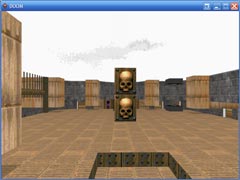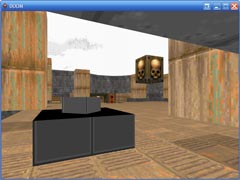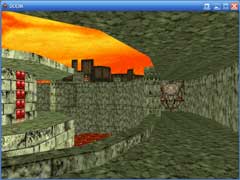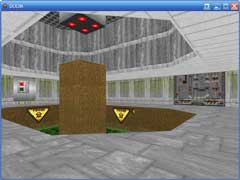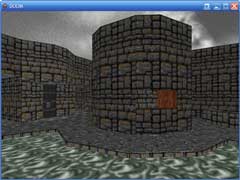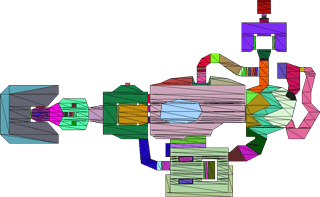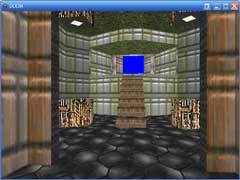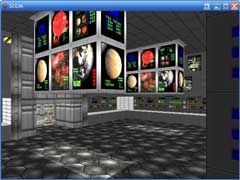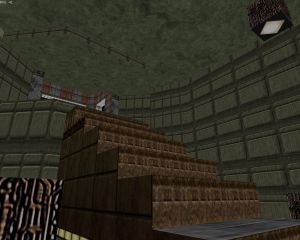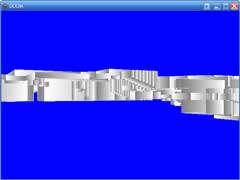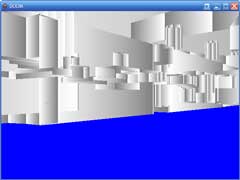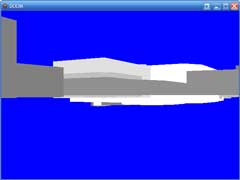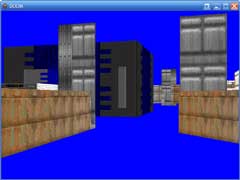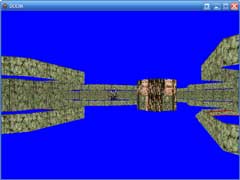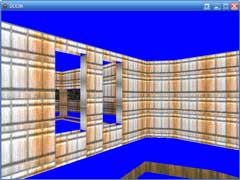DOOM Source
Thursday, 20th April 2006
You can download the source to the DOOM project below here.
It's a real mess in places, mainly in the way it loads level geometry. DirectX initialisation is hard-coded with no fallback code if some feature is missing or unsupported.
Usage: DOOM <iwad> <level>
eg:
DOOM DOOM2.WAD MAP31
DOOM DOOM.WAD E1M3
DOOM TNT.WAD MAP03
Keys: use the cursor keys to move around, A and Z to move up and down.
Broken:
- Floor splitting is abysmal. It is highly inefficient and occasionally wrong. The floor splitting code breaks sectors into horizontal spans which it then splits into triangles - uneven vertex placement results in largish cracks between sectors or "hairline" dancing-pixel cracks inside sectors. Large holes are usually the case of a sector that "overflows" another one. Ideally; decode floors via ssector/seg information or just use glBSP.
- Timing (level animation) is done via the primitive Timer class. If something starts to hog CPU time, the timers all slow down leading to inconsistent animation speeds.
- Scrolling walls and light effects are controlled differently; sector light effects (which affect a large amount of geometry) save the vertex array written to the vertex buffer away; this array is changed then sent to a vertex buffer, overwriting the existing data. The scrolling walls (affect a small amount of geometry) read the vertex buffer, alter the texture coordinates, then write it back. This results in a confict; if a linedef has both scrolling AND lighting effects, every time the light level changes the scroll offset is reset to the original linedef's value.
- Skies that occlude geometry that is visible normally aren't handled correctly.
- Player start angle is occasionally backwards.
- Some of the more bizarre walls still don't display properly.
Lights, camera - action!
Wednesday, 22nd March 2006
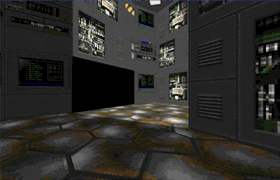
I've also added a MUS lump (music format used by DOOM) player, using the MIDI message functions in winmm. The only feature left unsupported is the pitch wheel, as I can't quite work out the MIDI command for it.
If somebody could please explain the logic behind MUS, please tell me. It's essentially the same as MIDI, except each command has a different byte (so you have to convert to the correct byte first), uses channel 15 for percussion (so you have to swap 15 with 9 and 9 with 15 - as 9 is the MIDI percussion channel) and uses a controller for a patch change, whereas MIDI has a specific patch change command rather than lumping it with the controllers.
Making the world live
Monday, 20th March 2006
It might have looked liked I'd got all the walls drawing and texturing correctly, some particular combinations were still wrong.
Some walls looked completely wrong until you got up close, and with a flickering burst of z-fighting they'd resolve themselves. Or rather, fuzzy patches would resolve themselves.
This would not do!
Here's a good (or bad) example of where things were going wrong:
Something tells me I shouldn't hire the UAC's architect. The problem, it turns out, is the way connected sectors handle which coordinates to use for upper, middle and lower sections.
I was using the current sector's ceiling and floor height as the midsection, and the areas between the two sectors' ceilings or floors as the upper and lower coordinates.
The problem is if the current sector is taller than the adjacent sector. This makes the "middle" section very tall, and the upper and lower sections end up folding back down on themselves - like this:
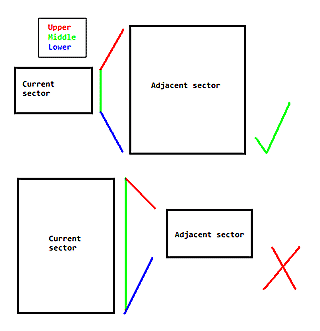
I tried all combinations of ordering, none of which worked - either rendering that area correctly and removing old healthy walls; or displaying correctly but with texture coordinates awry. The solution in the end was very simple - sort the four height levels into TopCeiling, MidCeiling, MidFloor, and LowFloor.
Two things in that image are wrong. Most noticably - no alpha blending on the walls. You should be able to see through that grille. The second is that in the real DOOM, you can see under the grille itself.
The latter is quite easy to fix; looking in my WAD spec guide, I see:There are some transparent textures which can be used as middle textures on 2-sided sidedefs (between sectors). These textures need to be composed of a single patch (see [8-4]), and note that on a very tall wall, they will NOT be tiled. Only one will be placed, at the spot determined by the "lower unpegged" flag being on/off and the sidedef's y offset. And if a transparent texture is used as an upper or lower texture, then the good old "Tutti Frutti" effect will have its way.
In short; if the ceiling_height - floor_height > texture_height then floor_height = ceiling_height - texture_height (the Z axis, floor height, points "upwards", so ceilings have a greater Z coordinate than floors).
As for transparency, my aim to keeping this simple prevailed. Rather than sort the walls from back to front manually, I isolate the vertex buffers relating to textures with transparent areas and draw them after all the other walls. This would still lead to problems where looking through one transparent wall at another would leave holes in the far wall if it had been drawn afterwards, so I draw all the walls twice - the first time with z-writes disabled, the second with them reenabled.
The entry room from E1M3 with alpha blending and fixed wall coordinates looks like this, now:
I bought the collector's edition of DOOM for this project (it's quite cheap) and picked it up over the weekend. Mostly because it had Final DOOM on it (I only had Ultimate DOOM and DOOM II), but also because it claimed to run on Windows XP. It didn't even list DOS as a supported platform.
I was surprised to find that it's just DOOM95, which quite simply doesn't work on Windows XP. Neither does it work on 2000. The mouse doesn't work, and the colours are all wrong. Using XP's compatibility mode and 256 colour mode seems to cure it for a few minutes before it goes all weird again. (I don't know if it's entirely graphics-card related, as DOOM95 ran fine under Windows 95 on my old PC - then went funky colours after upgrading to 2000).
There is a relevance to this - loading the Plutonium WAD file slowed my PC right down for about 3 minutes - though the CPU usage was extremely low. The reason? A slight memory hogging issue...
Turns out it was trying to decode some extra files that had appeared in the WAD file as images, with dimensions of 10,000 by 10,000 or greater. No wonder it was consuming memory at such a rate!
Loading the Plutonia WAD also showed this error:
The pillar isn't really meant to be a pillar - in reality, only the top skull is meant to display. This sounds a bit like a middle section not tiling glitch - and looking at the lines that make up the skull, each is marked as double sided. Double sided lines are generally used for transparent wall sections - so rather than check the transparency of a wall section, I check to see if it's double sided or not.
Much better!
Two things that made the DOOM environment come to life - excluding, of course, actually coming to life and moving around - were the changes in sector lighting and animated textures on floors and walls.
Adjusting the light level of sectors - blinking or pulsating lights, for example - would require quite a lot of code. On the other hand, all the animated textures need is a bit of extra code on the WAD parser to work out which textures come between the animated texture markers and a bit of extra code on the renderer to swap texture indices around every ~300ms.

Well, that's the easy bit done. Interesting to note, however, that Doomsday (jDoom) - or at least my copy of it - does not handle animated textures correctly. A particular set of textures used in Final DOOM - the spinning tape drives on computers - appear static in jDoom, or only use the first few frames.
Currently, the level's geometry is split up by texture - so I cycle through each different texture, setting it as current, then sending all the geometry that uses that texture (as a vertex buffer) to be drawn. Better control over sectors would mean that I should split by texture, then by sector.
Unfortunately, my attempt resulted in a, uh, slight performance hit. By slight, I mean from ~370FPS on my Radeon 9550 to ~4FPS. Whoops!
It turns out that I was accidentally repeating each sector - even with that fixed, I was still at about 50FPS.
It would probably be simpler - not to mention faster - to order the vertices in sector order, but to record the offset and length inside the vertex buffer for each sector so that should I need to change it I could very easily lock and update it. To put it more clearly, I should maintain a list, for each sector, recording which vertex buffers form part of it and the offset and length (in bytes) to the vertices specific to that sector. That way I can easily (not to mention quickly) tweak the vertices to my heart's content - be it adjusting their Color property to flicker lights, or their heights to open and close doors.
No more holes.
Friday, 17th March 2006
With the exception of some very bizarrely shaped sectors, I've patched up the holes by making the floor splitter a bit more intelligent. It also removes some redundancies.
The more exotic levels generate about 5000 triangles, which is fairly reasonable.
Now I need to do battle with the physically impossible levels DOOM creates...
In DOOM, skies and floors are actually marked as the special texture SKY_1. However, rather than drawing it using the normal mapping, it's drawn fixed to the background.
I'm currently just drawing a sky cylinder, and not drawing ceilings where the sky texture would normally be. I need to find some way of masking out the buildings that shouldn't be visible.
World's Worst Sector Splitter
Thursday, 16th March 2006
As with many programming problems, a potential solution presents itself at about 2AM when you suddenly awake and hunt paper and pencil before the brilliant idea vanishes into the groggy murk that is forgetfulness.
In this instance, a solution did present itself, but it's far from 'brilliant'.
I was pondering DOOM's floors, and how to split them up. I came up with a simple, optimal solution - optimal, provided that the sector I was splitting into triangles was a rectangle with sides perfectly aligned the the (x,y) axes. Happily, DOOM follows that pattern fairly often.
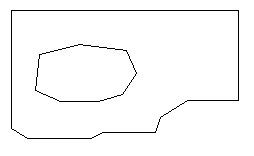
Here we have the typical sector. It's sector number one from E1M1, the ground that surrounds the acid pool outside the window. As you can see, it's not entirely convex, and has a hole in the middle. I have access to the lines and points that surround the sector.
My technique runs like this:
- Split the sector up into horizontal spans. To do this, I cycle through every single line in the sector, and for every different Y coordinate I split the sector.
- For each individual span, go through each line in the sector. If it's completely outside the span, discard it. If it's partially outside (no line will ever have a point half-way inside the span), clip it to the upper/lower Y bounds.
- Sort these lines from left to right, then group into pairs. Each pair, when combined with the top and bottom Y boundary, forms a trapezium. Split this into two triangles - there's a part of your floor.
This method is fairly simple, and appears to work pretty well:
Note the large magenta shape at the top (maze in E1M2). That's a single sector!
The image is less pretty if I dump out an image showing the triangles generated:
Hopefully that makes my method slightly clearer.
For some areas, it does pretty well. In others (sectors not perfectly aligned to the (x,y) axes) it generates an absolutely horrible mess of triangles.
Grouping walls by texture and generating a new vertex buffer for each texture group worked pretty well, so I've done the same for floors.
The first floor test looked pretty good (minus texture coordinates):
...so I fixed it up a bit, and flipped the vertex order to support ceilings as well.
One problem I had been worried about had reared it's ugly head, however - hairline cracks between triangles, showing the lovely bright blue through the dark and dismal UAC facility. It was trivial to fix, however; replace the floating-point linear interpolation (to clip lines to the single horizontal span in the floor splitting code) with the integer-based method. This got rid of all the rounding errors, and the cracks were gone.
The floor splitting code might inefficient, but it is simple - even then, however, it does fail on certain segments resulting in slightly-larger-than-hairline cracks on certain levels.
I'm not quite sure why that's happening. I have a hunch that in certain cases there is an extra line when breaking up sectors into horizontal spans and you end up with an odd number of dividing lines. In some cases, this extra line is at the end - and it is ignored safely. If it's at the beginning, though, everything is shunted along one and the whole sector span is drawn incorrectly.
Also, (and this can be verifed), some sector floors/ceilings end up being drawn back-to-front, and fall prey to the backface culling. Ducking below the surface of the floor, you can clearly see the missing floor deciding to be a ceiling.
One potential improvement would be to split the floor twice - once in horizontal spans, once in vertical spans - and use the one that produces the least triangles.
The texturing issues from last post were fixed with a variety of code changes - some sector-to-sector wall segments were being drawn upside down (the code now flips the heights around so they're in the correct order); the light level of a sector's wall is calculated by the brightest between it and any adjacent sector; lower texture pegging fixed to align correctly.
Managed DirectX is awesome
Monday, 13th March 2006
A few years back I had a go with DirectX 8, helped along by the excellent DirectX4VB website and tutorials.
The best thing I cranked out was a simple DOOM-ish 3D engine, minus sprites (just walls and floors).
(All images are click-for-big).
I fancied another go, this time not in VB6 but in C# and not with DirectX 8 but Managed DirectX 9.
I had an old copy of the SDK so got the obligatory spinning coloured untextured triangle going, then hunted for a proper project to learn with.
Keeping with the theme of last time's venture, I decided to go back to DOOM, but not DOOM-ish - I'd load the levels and graphics from an original DOOM WAD file. There's something oddly satisfying about pressing F5 and watch a familiar 3D world spring into view ![]()
I'd written a very simple VB.NET WAD resource viewer, so rewrote the various graphics functions in C# and dug out a hex editor to work out what goes on inside DOOM.
Each level has a similar bunch of data lumps ("lump" is the name of a single resource within the WAD); THINGS that define the location of objects inside the map, NODES for the BSP tree, VERTEXES for the vertices that make up a level and so on.
One problem with DOOM is that there is no "vectorised" floor. The walls are easy enough; by studying the LINEDEF/SIDEDEF/SECTOR lumps you can work out the VERTEXES you need to use to build up a single wall. Floors are filled in after the walls are drawn; to be able to draw a floor on 3D hardware I'd need to split down the sectors into triangles manually. For the moment I shall concentrate on walls.
A quick bit of coding later; drawing by splitting each wall into a small vertex buffer (two triangles) then drawing (one end of the wall is white, the other grey) gives me this:
Something's working... but something isn't, as well. Moving around looks odd, and no wonder; no Z-buffering!
Switching on Z-buffering and colouring each wall based on the light level of the sector gives me these rather better results:
One thing that I've never been aware of when it comes to 3D graphics are the best practices for how I send data to the graphics card. For this, I've grouped every single wall by texture. I've loaded all the textures I'll need for the walls into an array, then built up a vertex buffer for each texture's walls. When I render, I cycle through each texture, setting it as active then drawing that texture's vertex buffer. It appears to be fast enough, but then again DOOM with it's ~2000 poly levels isn't demanding much!
Texture mapping adds a lot of detail to the world... so:
The textures appear a bit odd as they're being simply stretched to fill the entire wall they're put on rather than tile neatly as DOOM intended. That's an easy enough fix:
There are still some texturing glitches, most noticeably on walls where the lower texture (the texture that spans the gap between the floors of two sectors of different heights) where they are marked as "unpegged":
I can't quite work out how the texturing is meant to go there... so I've left it for the moment, and had a bash at floors.
It appears that a combination of subsectors (SSECTORS) and segments (SEGS) can be used to represent convex polygons that make up sectors. I added a bit of code to the level loader that rips out the subsector and segment information - it produced these images:
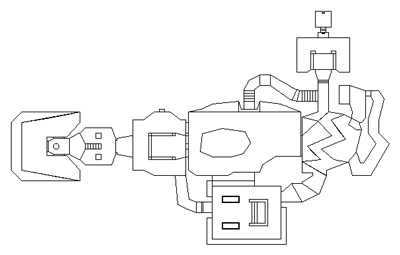
Subsectors

Segments
This doesn't look too promising; if you look at the central part (where the green acid pool is -- this is E1M1) you can see there's a rather large area with no segments in it at all. I added a simple bit of code that broke up the segments into fans; here's the result:
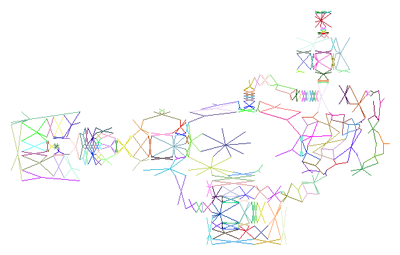
The hole is very noticable in that image. Quite a few of the segments are made up of single lines (just two points), which leads me to believe that I'm thinking that they're something they're not.
For the moment DOOM has to go without floors.
Subscribe to an RSS feed that only contains items with the MDX DOOM tag.

